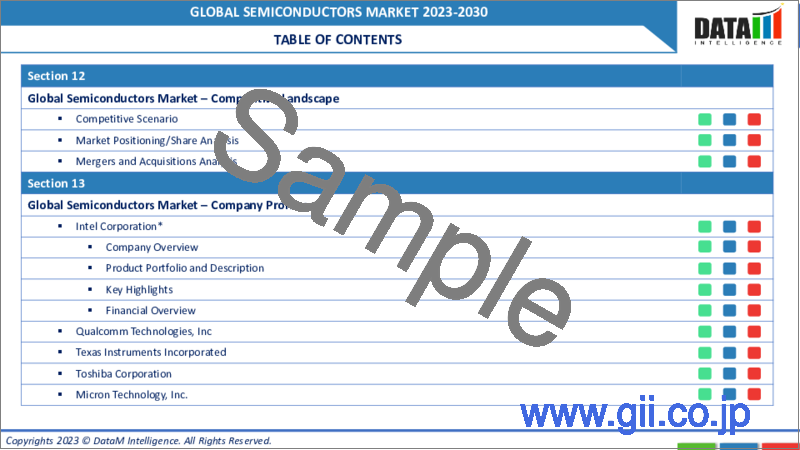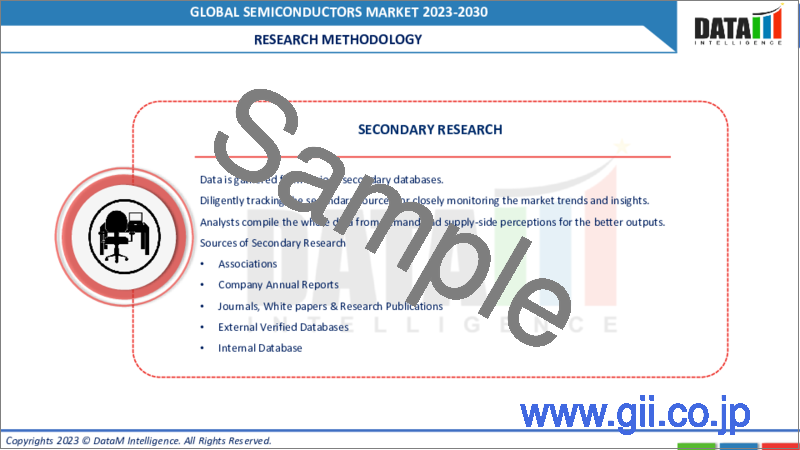|
|
市場調査レポート
商品コード
1304527
半導体の世界市場-2023年~2030年Global Semiconductors Market - 2023-2030 |
||||||
カスタマイズ可能
適宜更新あり
|
|||||||
| 半導体の世界市場-2023年~2030年 |
|
出版日: 2023年07月07日
発行: DataM Intelligence
ページ情報: 英文 212 Pages
納期: 即日から翌営業日
|
- 全表示
- 概要
- 目次
市場概要
半導体の世界市場は、2022年に6,406億米ドルに達し、2030年には1兆1,328億米ドルに達すると予測され、予測期間2023-2030年のCAGRは7.5%で成長すると予測されます。世界の半導体市場は、技術進歩の増加、コネクテッドデバイスの普及、スマートシティの台頭、産業全般にわたる効率的で高性能な電子システムの需要に牽引され、成長軌道を継続すると予想されます。
2023年6月6日、インド政府はModified Semicon India Programの下、インドにおける半導体工場およびディスプレイ工場の設立を新たに募集します。インド半導体ミッションは、インド国内の半導体およびディスプレイ製造エコシステムを発展させるため、Modified Semicon India Programの実施責任を委託された指定結節機関として、申請を受理します。
Modified Semicon India Programでは、インドにあらゆるノード(成熟ノードを含む)の半導体工場を設立する企業/コンソーシアム/ジョイントベンチャーに対し、プロジェクト費用の50%の財政的インセンティブが与えられます。そのため、この地域は半導体需要の急増を目の当たりにしており、地域別シェアの1/3以上を占めています。
市場力学
集積回路需要の拡大
自動車業界では、ADAS(先進運転支援システム)、インフォテインメント・システム、エンジン管理、コネクティビティ・ソリューションなど、さまざまな用途でICへの依存度が高まっています。電気自動車(EV)と自律走行技術の成長は、ICの需要をさらに促進しています。自動車部門では、エレクトロニクスとコネクティビティ機能の統合が進んでおり、IC需要を大幅に押し上げています。
製造業では近年、産業用オートメーションとロボットの導入が急増しています。ICは、オートメーションに使用される制御システム、センサー、アクチュエーター、その他の部品に不可欠です。産業界が業務の生産性、効率、接続性の向上を目指しているため、産業オートメーションにおけるICの需要は大幅に伸びています。
カーエレクトロニクスの進歩
自動車がより技術的に進歩し、接続性が高まるにつれて、自動車産業における半導体部品の需要は急増しています。電気自動車の台頭は、半導体市場の大幅な拡大につながっています。
電気自動車には、高度な電源管理システム、バッテリー管理システム、モーター制御ユニット、充電インフラが必要であり、これらはすべて半導体技術に大きく依存しています。電動モビリティへの移行は、パワーエレクトロニクスと先進半導体ソリューションの需要を大幅に押し上げました。
半導体産業の周期性
半導体産業は周期的な好況と不況のサイクルを特徴とし、需給関係、マクロ経済状況、技術進歩など様々な要因の影響を受ける。半導体業界は、消費者の嗜好の変化、経済状況、業界特有の動向など、さまざまな要因によって需要が変動します。
需要が高い時期には、業界は成長し収益が増加します。しかし、不況期には需要が減少し、売上の減少、過剰在庫、半導体企業の財務上の課題につながる可能性があります。
COVID-19影響分析
パンデミックは、リモートワーク、オンライン教育、娯楽が普及するにつれて電子機器に対する需要の急増を生み出しました。これにより、ノートパソコン、タブレット、ゲーム機、その他の電子機器の需要が増加し、これらの製品に使用される半導体の需要増につながっています。
パンデミックは、eコマース、ビデオ会議、クラウド・コンピューティング、ストリーミング・プラットフォームなどのデジタル・サービスの普及を加速させました。これらのサービスはデータセンター、ネットワークインフラ、クラウドサービスに大きく依存しており、サーバーチップ、ネットワークチップ、データストレージコンポーネントの需要を牽引しています。
パンデミックは、半導体のような重要技術のための安全で信頼できるサプライチェーンの重要性を浮き彫りにしました。その結果、米国、日本、欧州連合(EU)を含む各国は、輸入への依存を減らし、自国の半導体能力を強化するため、国内半導体製造への投資計画を発表しました。
目次
第1章 調査手法と調査範囲
第2章 定義と概要
第3章 エグゼクティブサマリー
第4章 市場力学
- 影響要因
- 促進要因
- 集積回路の需要拡大
- カーエレクトロニクスの進歩
- 抑制要因
- 半導体産業の周期性
- 事業機会
- 影響分析
- 促進要因
第5章 産業分析
- ポーターのファイブフォース分析
- サプライチェーン分析
- 価格分析
- 規制分析
第6章 COVID-19分析
第7章 製品別
- 真性半導体
- 外因性半導体
第8章 材料別
- シリコン
- ガリウムヒ素
- ゲルマニウム
- 炭化ケイ素
- その他
第9章 コンポーネント別
- アナログIC
- 光半導体
- メモリー半導体
- マイクロ・コンポーネント
- ディスクリート・パワーデバイス
- その他
第10章 エンドユーザー別
- 自動車
- ヘルスケア
- 航空宇宙
- ネットワーク・通信
- コンシューマー・エレクトロニクス
- その他
第11章 地域別
- 北米
- 米国
- カナダ
- メキシコ
- 欧州
- ドイツ
- 英国
- フランス
- イタリア
- ロシア
- その他欧州
- 南米
- ブラジル
- アルゼンチン
- その他南米
- アジア太平洋
- 中国
- インド
- 日本
- オーストラリア
- その他アジア太平洋地域
- 中東・アフリカ
第12章 競合情勢
- 競合シナリオ
- 市況/シェア分析
- M&A分析
第13章 企業プロファイル
- Intel Corporation
- 会社概要
- 製品ポートフォリオと説明
- 財務概要
- 最近の動向
- Qualcomm Technologies, Inc
- Texas Instruments Incorporated
- Toshiba Corporation
- Micron Technology, Inc.
- Infineon Technologies
- Samsung Electronics
- NVIDIA Corporation
- Broadcom, Inc.
- SK Hynix
第14章 付録
Market Overview
The Global Semiconductors Market reached US$ 640.6 billion in 2022 and is expected to reach US$ 1,132.8 billion by 2030, growing with a CAGR of 7.5% during the forecast period 2023-2030. The Global Semiconductors Market is expected to continue its growth trajectory, driven by increasing technological advancements, the proliferation of connected devices, the rise of smart cities and the demand for efficient and high-performance electronic systems across industries.
On June 6, 2023, The Indian Government is inviting new applications for setting up semiconductor fabs and display fabs in India under the Modified Semicon India Program. India Semiconductor Mission will receive the applications, the designated nodal agency entrusted with the responsibility of implementing the Modified Semicon India Program to develop the country's semiconductors and display manufacturing ecosystem.
Under the modified program, a financial incentive of 50% of the project cost is available to companies/consortia/ joint ventures to set up semiconductor fabs in India of any node (including mature nodes). Therefore, the region has witnessed a surge in semiconductor demand, accounting for more than 1/3rd of the regional shares.
Market Dynamics
Growing Demand for Integrated Circuits
The automotive industry has increasingly relied on ICs for various applications, including advanced driver-assistance systems (ADAS), infotainment systems, engine management and connectivity solutions. The growth of electric vehicles (EVs) and autonomous driving technologies has further fueled the demand for ICs. The automotive sector's increasing integration of electronics and connectivity features drives IC demand significantly.
Industrial automation and robotics adoption in manufacturing has surged in recent years. ICs are essential for control systems, sensors, actuators and other components used in automation. As industries aim for increased productivity, efficiency and connectivity in their operations, the demand for ICs in industrial automation has grown substantially.
Advancements in Automotive Electronics
As vehicles become more technologically advanced and connected, the demand for semiconductor components in the automotive industry has surged. The rise of electric cars has led to a substantial increase in the market for semiconductors.
EVs require advanced power management systems, battery management systems, motor control units and charging infrastructure-all of which heavily rely on semiconductor technologies. The transition towards electric mobility has significantly boosted the demand for power electronics and advanced semiconductor solutions.
Cyclical Nature of the Semiconductor Industry
The industry is characterized by periodic boom and bust cycles, influenced by various factors such as supply-demand dynamics, macroeconomic conditions and technological advancements. The semiconductor industry experiences fluctuations in demand due to various factors, including changes in consumer preferences, economic conditions and industry-specific trends.
During periods of high demand, the industry experiences growth and increased revenue. However, during downturns, demand can decline, leading to reduced sales, excess inventory and financial challenges for semiconductor companies.
COVID-19 Impact Analysis
The pandemic created a surge in demand for electronics as remote work, online education and entertainment became more prevalent. This increased demand for laptops, tablets, gaming consoles and other electronic devices, leading to a higher demand for semiconductors used in these products.
The pandemic accelerated the adoption of digital services like e-commerce, video conferencing, cloud computing and streaming platforms. These services rely heavily on data centers, networking infrastructure and cloud services, driving the demand for server chips, networking chips and data storage components.
The pandemic highlighted the importance of secure and reliable supply chains for critical technologies like semiconductors. As a result, countries, including the U.S., Japan and the European Union, announced plans to invest in domestic semiconductor manufacturing to reduce reliance on imports and strengthen national semiconductor capabilities.
Segment Analysis
The Global Semiconductors Market is segmented based on product, material, component, end-user and region.
Owing to Bipolar Junction Transistors (BJTs) and Field-Effect Transistors (FETs), Extrinsic Semiconductor dominates the global market
Extrinsic semiconductors, particularly doped silicon, are essential for producing bipolar junction transistors (BJTs). BJTs are fundamental components used in various electronic devices, including amplifiers, switches and integrated circuits. The ability to dope semiconductors to create different regions with varying conductivity enables the operation of BJTs, significantly contributing to the semiconductor market's growth.
Extrinsic semiconductors are also crucial for developing field-effect transistors (FETs). FETs are another basic type of transistor widely used in various electronic devices, such as digital integrated circuits and memory chips.
By precisely doping the semiconductor material, FETs can be created with different channels (e.g., n-type or p-type) and electrical characteristics, enabling the efficient switching and amplification required in modern electronics. Therefore, the extrinsic product segment is expected to grow at the highest CAGR during the forecasted period.
Geographical Analysis
China's Manufacturing Powerhouse and R&D Investments
China has significantly contributed to the growth of the Global Semiconductors Market in recent years. The country has undertaken various initiatives and investments to boost its domestic semiconductor industry, which has had a ripple effect on the global market. China has emerged as a major manufacturing hub for semiconductors.
The country has numerous semiconductor fabrication plants (fabs) that produce a significant portion of the world's chips. For example, Semiconductor Manufacturing International Corporation (SMIC) is one of China's largest semiconductor foundries and plays a crucial role in the global supply chain.
China has been increasing its investments in semiconductor R&D to enhance domestic capabilities. The government has implemented policies and initiatives to support the development of the semiconductor industry, including the "Made in China 2025" plan. This plan focuses on promoting innovation, upgrading technology and increasing self-sufficiency in the semiconductor sector. Therefore, China accounts for more than half of the regional shares and is expected to dominate the regional market by a significant margin.
Competitive Landscape
The major global players include: Intel Corporation, Qualcomm Technologies, Inc, Texas Instruments Incorporated, Toshiba Corporation, Micron Technology, Inc., Infineon Technologies, Samsung Electronics, NVIDIA Corporation, Broadcom, Inc. and SK Hynix.
Why Purchase the Report?
- To visualize the Global Semiconductors Market segmentation based on product, material, component, end-user and region and understand key commercial assets and players.
- Identify commercial opportunities by analyzing trends and co-development.
- Excel data sheet with numerous data points of semiconductors market-level with all segments.
- PDF report consists of a comprehensive analysis after exhaustive qualitative interviews and an in-depth study.
- Product mapping available as Excel consisting of key products of all the major players.
The Global Semiconductors Market Report Would Provide Approximately 69 Tables, 73 Figures And 212 pages.
Component 2023
- Manufacturers/ Buyers
- Industry Investors/Investment Bankers
- Research Professionals
- Emerging Companies
Table of Contents
1. Methodology and Scope
- 1.1. Research Methodology
- 1.2. Research Objective and Scope of the Report
2. Definition and Overview
3. Executive Summary
- 3.1. Snippet by Product
- 3.2. Snippet by Material
- 3.3. Snippet by Component
- 3.4. Snippet by End-User
- 3.5. Snippet by Region
4. Dynamics
- 4.1. Impacting Factors
- 4.1.1. Drivers
- 4.1.1.1. Growing Demand for Integrated Circuits
- 4.1.1.2. Advancements in Automotive Electronics
- 4.1.2. Restraints
- 4.1.2.1. Cyclical Nature of the Semiconductor Industry
- 4.1.3. Opportunity
- 4.1.4. Impact Analysis
- 4.1.1. Drivers
5. Industry Analysis
- 5.1. Porter's Five Force Analysis
- 5.2. Supply Chain Analysis
- 5.3. Pricing Analysis
- 5.4. Regulatory Analysis
6. COVID-19 Analysis
- 6.1. Analysis of COVID-19
- 6.1.1. Scenario Before COVID
- 6.1.2. Scenario During COVID
- 6.1.3. Scenario Post COVID
- 6.2. Pricing Dynamics Amid COVID-19
- 6.3. Demand-Supply Spectrum
- 6.4. Government Initiatives Related to the Market During the Pandemic
- 6.5. Manufacturers' Strategic Initiatives
- 6.6. Conclusion
7. By Product
- 7.1. Introduction
- 7.1.1. Market Size Analysis and Y-o-Y Growth Analysis (%), By Product
- 7.1.2. Market Attractiveness Index, By Product
- 7.2. Intrinsic Semi-Conductors*
- 7.2.1. Introduction
- 7.2.2. Market Size Analysis and Y-o-Y Growth Analysis (%)
- 7.3. Extrinsic Semi-Conductors
8. By Material
- 8.1. Introduction
- 8.1.1. Market Size Analysis and Y-o-Y Growth Analysis (%), By Material
- 8.1.2. Market Attractiveness Index, By Material
- 8.2. Silicon*
- 8.2.1. Introduction
- 8.2.2. Market Size Analysis and Y-o-Y Growth Analysis (%)
- 8.3. Gallium Arsenide
- 8.4. Germanium
- 8.5. Silicon Carbide
- 8.6. Others
9. By Component
- 9.1. Introduction
- 9.1.1. Market Size Analysis and Y-o-Y Growth Analysis (%), By Component
- 9.1.2. Market Attractiveness Index, By Component
- 9.2. Analog IC*
- 9.2.1. Introduction
- 9.2.2. Market Size Analysis and Y-o-Y Growth Analysis (%)
- 9.3. Optical Semiconductors
- 9.4. Memory Type Semiconductors
- 9.5. Micro Components
- 9.6. Discrete Power Devices
- 9.7. Others
10. By End-User
- 10.1. Introduction
- 10.1.1. Market Size Analysis and Y-o-Y Growth Analysis (%), By End-User
- 10.1.2. Market Attractiveness Index, By End-User
- 10.2. Automotive*
- 10.2.1. Introduction
- 10.2.2. Market Size Analysis and Y-o-Y Growth Analysis (%)
- 10.3. Health Care
- 10.4. Aerospace
- 10.5. Networking and Communication
- 10.6. Consumer Electronics
- 10.7. Others
11. By Region
- 11.1. Introduction
- 11.1.1. Market Size Analysis and Y-o-Y Growth Analysis (%), By Region
- 11.1.2. Market Attractiveness Index, By Region
- 11.2. North America
- 11.2.1. Introduction
- 11.2.2. Key Region-Specific Dynamics
- 11.2.3. Market Size Analysis and Y-o-Y Growth Analysis (%), By Product
- 11.2.4. Market Size Analysis and Y-o-Y Growth Analysis (%), By Material
- 11.2.5. Market Size Analysis and Y-o-Y Growth Analysis (%), By Component
- 11.2.6. Market Size Analysis and Y-o-Y Growth Analysis (%), By End-User
- 11.2.7. Market Size Analysis and Y-o-Y Growth Analysis (%), By Country
- 11.2.7.1. The U.S.
- 11.2.7.2. Canada
- 11.2.7.3. Mexico
- 11.3. Europe
- 11.3.1. Introduction
- 11.3.2. Key Region-Specific Dynamics
- 11.3.3. Market Size Analysis and Y-o-Y Growth Analysis (%), By Product
- 11.3.4. Market Size Analysis and Y-o-Y Growth Analysis (%), By Material
- 11.3.5. Market Size Analysis and Y-o-Y Growth Analysis (%), By Component
- 11.3.6. Market Size Analysis and Y-o-Y Growth Analysis (%), By End-User
- 11.3.7. Market Size Analysis and Y-o-Y Growth Analysis (%), By Country
- 11.3.7.1. Germany
- 11.3.7.2. The UK
- 11.3.7.3. France
- 11.3.7.4. Italy
- 11.3.7.5. Russia
- 11.3.7.6. Rest of Europe
- 11.4. South America
- 11.4.1. Introduction
- 11.4.2. Key Region-Specific Dynamics
- 11.4.3. Market Size Analysis and Y-o-Y Growth Analysis (%), By Product
- 11.4.4. Market Size Analysis and Y-o-Y Growth Analysis (%), By Material
- 11.4.5. Market Size Analysis and Y-o-Y Growth Analysis (%), By Component
- 11.4.6. Market Size Analysis and Y-o-Y Growth Analysis (%), By End-User
- 11.4.7. Market Size Analysis and Y-o-Y Growth Analysis (%), By Country
- 11.4.7.1. Brazil
- 11.4.7.2. Argentina
- 11.4.7.3. Rest of South America
- 11.5. Asia-Pacific
- 11.5.1. Introduction
- 11.5.2. Key Region-Specific Dynamics
- 11.5.3. Market Size Analysis and Y-o-Y Growth Analysis (%), By Product
- 11.5.4. Market Size Analysis and Y-o-Y Growth Analysis (%), By Material
- 11.5.5. Market Size Analysis and Y-o-Y Growth Analysis (%), By Component
- 11.5.6. Market Size Analysis and Y-o-Y Growth Analysis (%), By End-User
- 11.5.7. Market Size Analysis and Y-o-Y Growth Analysis (%), By Country
- 11.5.7.1. China
- 11.5.7.2. India
- 11.5.7.3. Japan
- 11.5.7.4. Australia
- 11.5.7.5. Rest of Asia-Pacific
- 11.6. Middle East and Africa
- 11.6.1. Introduction
- 11.6.2. Key Region-Specific Dynamics
- 11.6.3. Market Size Analysis and Y-o-Y Growth Analysis (%), By Product
- 11.6.4. Market Size Analysis and Y-o-Y Growth Analysis (%), By Material
- 11.6.5. Market Size Analysis and Y-o-Y Growth Analysis (%), By Component
- 11.6.6. Market Size Analysis and Y-o-Y Growth Analysis (%), By End-User
12. Competitive Landscape
- 12.1. Competitive Scenario
- 12.2. Market Positioning/Share Analysis
- 12.3. Mergers and Acquisitions Analysis
13. Company Profiles
- 13.1. Intel Corporation*
- 13.1.1. Company Overview
- 13.1.2. Product Portfolio and Description
- 13.1.3. Financial Overview
- 13.1.4. Recent Developments
- 13.2. Qualcomm Technologies, Inc
- 13.3. Texas Instruments Incorporated
- 13.4. Toshiba Corporation
- 13.5. Micron Technology, Inc.
- 13.6. Infineon Technologies
- 13.7. Samsung Electronics
- 13.8. NVIDIA Corporation
- 13.9. Broadcom, Inc.
- 13.10. SK Hynix
LIST NOT EXHAUSTIVE
14. Appendix
- 14.1. About Us and Services
- 14.2. Contact Us






